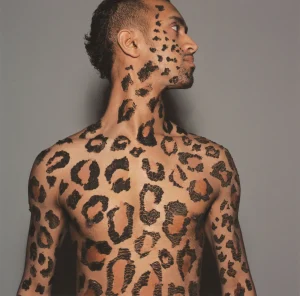In early 2004, long before The Art House established its permanent space in Wakefield, the arts organisation supported emerging artists through residencies at partner venues through its More Than 12 programme.
TAH supported Hetain Patel, who was hosted at 20/21 Visual Arts Centre in Scunthorpe. This three-month residency marked a significant moment in Patel’s career, leading to his first solo exhibition, A Third Place, which explored the complexities of cultural identity and the intersection of different worlds.
Patel’s residency centred on the struggle of balancing multiple identities, in particular, the tension of living between two cultures. As a second-generation British Asian, Patel navigates the space between his inherited cultural heritage and the influences of British society. His exploration of this hybrid identity is both personal and universal, reflecting broader questions about cultural responsibility, belonging, and the self. Patel’s aim is not only to examine where he fits within these cultural narratives but to actively construct his own identity, which he sees as being in his own hands. As he explained: “My work centres around the struggle to place my identity between two very different cultures. I try to address what it means to have a social and cultural responsibility, and where one lies in relation to this. I approach this issue from my point of view as a second-generation British Asian.”
On residency Patel’s approach to identity involved a process of self-styling, using Henna and Kanku paste – traditional materials used in Hindu ceremonies – to decorate his body. These play a significant role in Hindu prayer and marriage rituals, and become a metaphor for the way in which he is trying to “paint” or define his identity. The use of Henna patterns, both intricate and symbolic, speaks to his dual cultural heritage, a blend of traditional Indian customs and Western influences. This physical act of decorating his body is not just ceremonial; it is a symbolic and artistic reflection of the negotiation of identity.
Throughout the residency, Patel documented the process of painting his torso, using film to capture the action over hours – mirroring the time-intensive nature of Hindu marriage ceremonies. The act of applying traditional markings to his skin was not only about cultural ritual, but also about self-exploration and self-representation. Patel turned the act of creating art into a meditation on how identity is shaped through both external symbols and internal experiences.
The residency also saw Patel experimenting with other objects of cultural and ritual significance, including garlands of flowers and ceremonial attire, which featured prominently in his self-portraits. These pieces, which feature the artist’s body adorned with culturally rich symbols, take on an added layer of meaning when viewed in contrast with the artist’s averted gaze. Patel intentionally avoids eye contact with the camera, leaving his exposed torso as a vulnerable display. This gesture underscores the tension in his work: while the body is adorned with signs of cultural identity, the act of avoiding the camera introduces a contradiction, suggesting a disconnection between cultural symbols and personal identity.



One of the key themes Patel explored during his residency was the idea of “changing one’s spots.” He used the markings on a leopard as a metaphor for identity. Just as an animal’s unique patterns can serve as camouflage in one environment, these very same markings can stand out in a different context. This duality of belonging and standing out is central to Patel’s exploration of how identity can be fluid, and how cultural markers can both integrate and isolate an individual depending on the context.
Patel also worked with local young people in Scunthorpe, leading workshops that explored how clothing and dress codes contribute to the construction of identity. This collaborative process encouraged participants to reflect on what they wear and how it makes them feel. Through a combination of video and photography, Patel documented how rituals and dress can alter not only an individual’s perception of self, but also how others perceive them. This became the basis for a parallel exhibition, Hidden Identities, which investigated the impact of conventional clothing on self-image and societal expectations.
Patel’s residency at 20/21 Visual Arts Centre provided him with a platform to experiment with video, photography, and self-portraiture, while also exploring deeply personal and philosophical questions about identity, culture, and the ways in which we perceive ourselves and others. The work created during this time laid the foundation for Patel’s continued exploration of these themes in his later work, which often blends the personal with the universal, the traditional with the contemporary, and the symbolic with the self-reflexive.

